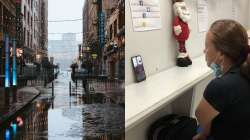2020: Quarantine & lockdown became household terms, grandma learned to make video calls
While terms like quarantine, sanitisation, containment zones or hotspots have been in use in medical or military parlance, they remained part of the esoteric vocabulary of experts or people working in the domain, such as security personnel at airports. However, with the unchecked spread of COVID-19, usage of these technical terms, particularly quarantine and sanitisation became fairly commonplace in 2020.

From quarantine to lockdown and containment zones to social distancing, these terms were sparsely used until the COVID-19 pandemic hit the world, when these became part of the common man's vocabulary in 2020. While the rest of the world first learned about the COVID-19 or Sars-Cov-2 from China when the first case globally was reported in Wuhan city, the spread of the deadly novel coronavirus brought in its wake sickness, death and a new set of lexicon, which was perhaps alien to the contemporary population.
And, rightly so, as this is the pandemic of the century, with the previous major one being the Spanish Flu of 1918-19 which had also ravaged the world soon after the end of the Great War.
While terms like quarantine, sanitisation, containment zones or hotspots have been in use in medical or military parlance, they remained part of the esoteric vocabulary of experts or people working in the domain, such as security personnel at airports.
However, with the unchecked spread of COVID-19, usage of these technical terms, particularly quarantine and sanitisation became fairly commonplace in 2020.
Besides, the health bulletins and advisories issues by state and central government authorities used these terms on a daily basis, and media reportage incorporating these 'novel terms' made them even more household.
Such had been the popularity and frequency of these words in written and verbal communications that Cambridge Dictionary named quarantine as word of the year 2020, while lockdown adjudged word of the year by Collins Dictionary.
The government announcing a series of lockdowns from late March onwards, made this term a domestic word, Lockdown 1.
0, Lockdown 2.
0 and so on, and followed by successive 'Unlocks'.
During a lockdown, citizens were not allowed to come out of their homes, except authorised persons and police and security staff, to contain the spread of infection.
From rickshaw-pullers to CEOs, and grocery vendors to university professors, these jargons became the common verbal currencies, cutting across varied geographies, demographies, and cultures.
From London to Lucknow and Washington to Warangal, these terms became as commonplace as wearing masks and carrying a bottle of sanitiser or maintaining 'social distancing'.
The existing meaning of quarantine is "a specific period of time in which a person or animal that has a disease, or may have one, must stay or be kept away from others in order to prevent the spread of the disease".
The term 'self-isolation' or loosely called isolation was also used interchangeably throughout the period of the pandemic, whose symptomatic and moderate cases were to be sent to hospitals, and asymptomatic and mild ones kept under 'home isolation', a term popularised by the Delhi government during its tough combat against the invisible enemy that had no face and knew no borders.
Suranjit Chatterjee, a senior consultant at Apollo Hospitals, said, similar measures were taken during the Spanish Flu too, with issuance of 'stay at home' orders, to avoid people coming in contact with potential infected persons.
"Posters and huge banners were made to spread awareness, today it's easier to tell people using TV broadcast and social media, but the pandemic has certainly made these technical phrase so common among the lay people," he said.
Phrases like 'containment zones' or 'hotspots' -- area where at least three positive cases have been found; and 'social distancing' -- physical separation between two persons to check spread of infection -- became the currencies of a 'new normal', adding another flavour to the lexicon, medical or otherwise.
Some of these phrases also drew mirth on the social media initially, as people grappled with a rapidly spreading virus that has affected over one crore people in India in 2020 alone, and more than 6.
25 lakh people in the national capital, with over 10,000 fatalities in Delhi.
The Twitterati even had 'coined' a Hindi word for 'social distancing' -- TAN-DOORI, with 'tan' meaning body and 'doori' distance, a clever wordplay on a famous way to cook a dish in a small furnace or 'tandoor'.
However, it wasn't just the new vocabulary the world adjusted to, but also new communication skills as it went from viral to virtual to stay connected in a COVID-hit world.
Amid the height of the pandemic, when fear gripped the psyche of people who were confined to their homes, online sessions, video calls and meetings over internet replaced face-to-face chit-chats and board room conferences, and just a polite 'namaste' instead of the usual handshake or an affectionate hug became the new salutation of the new normal.
People in their 70s and 80s who had been born in the analogue rotary telephone era, learned to make WhatsApp video calls and children in primary schools learned the ropes to attend online classes through Zoom platform.
Wedding, funerals, court hearings all took a new virtual avatar, seminars became webinars, and some internet-based firms even saw a business opportunity in it, and brought online dating services, as life had to move on.
Old-age people who were earlier averse to using smart phones, became so conversant with it, they dialled up their children and grandchildren with an unassuming ease.
As the world navigates through a new year, the social habits, precautionary measures and resulting cultural changes, adopted in 2020 to fight COVID-19, it seems will stay on with them for a long time in 2021 and beyond.